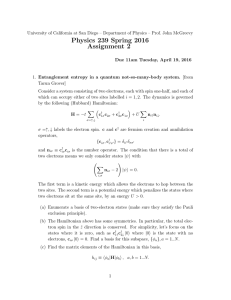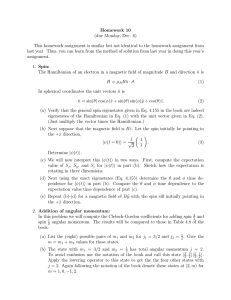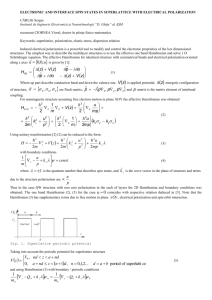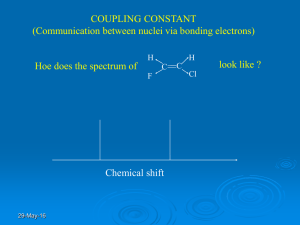Document 13552259
advertisement
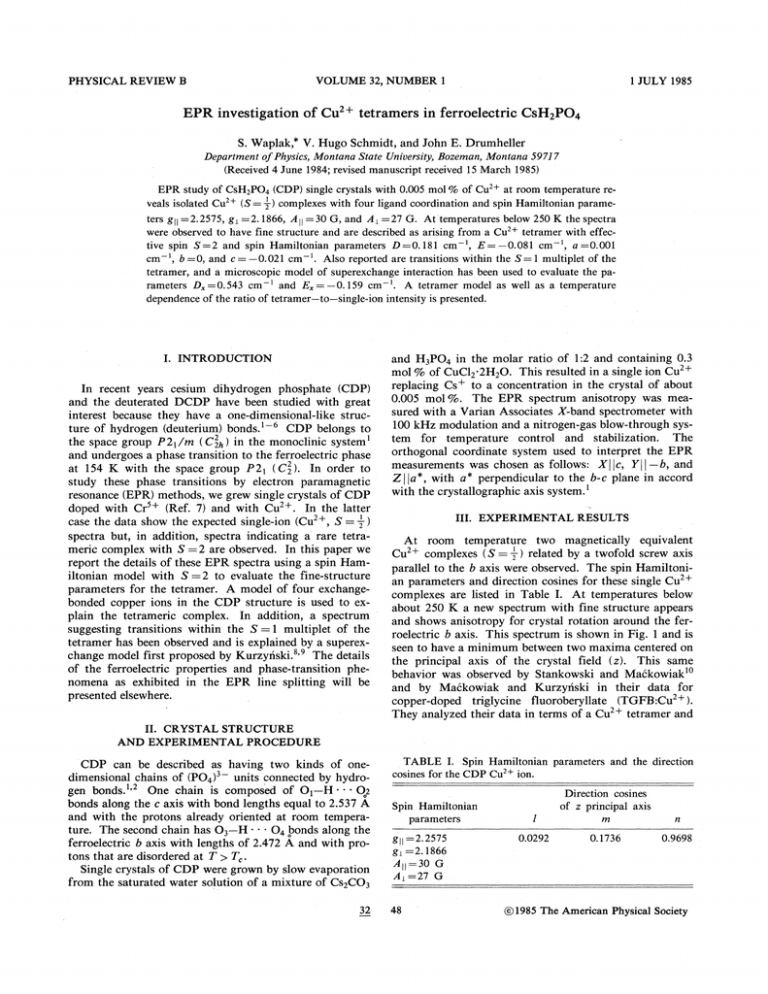
PHYSICAL REVIE% B
VOLUME 32, NUMBER
1
1
JULY 1985
EPR investigation of Cu + tetrarners in ferroelectric CsH2PO4
S. Waplak, * V. Hugo Schmidt, and John E. Drumheller
Department of Physics, Montana State Uniuersity, Bozeman, Montana 5971 7
{Received 4 June 1984; revised manuscript received 15 March 1985)
+ at room temperature remol%%uo of Cu
+
=
veals isolated Cu
{S 2 ) complexes with four ligand coordination and spin Hamiltonian parame2. 1866, 3 ——30 G, and 3& —
ters g~~ —
2. 2575, g& —
27 G. At temperatures below 250 K the spectra
were observed to have fine structure and are described as arising from a Cu + tetramer with effec0. 081 cm ', a=0. 001
tive spin S=2 and spin Hamiltonian parameters D=0. 181 cm ', E= —
cm ', b=0, and c= —
0.021 cm '. Also reported are transitions within the 5=1 multiplet of the
tetramer, and a microscopic model of superexchange interaction has been used to evaluate the pa0. 159 cm '. A tetramer model as well as a temperature
rameters D =0. 543 cm ' and E = —
single-ion intensity is presented.
to —
dependence of the ratio of tetramer —
EPR study of CsH2PO4 {CDP}single crystals with 0.005
~~
I. INTRODUCTION
In recent years cesium dihydrogen phosphate (CDP)
and the deuterated DCDP have been studied with great
strucinterest because they have a one-dimensional-like
ture of hydrogen (deuterium) bonds. '
CDP belongs to
the space group P2~lm (Cqh) in the monoclinic system'
and undergoes a phase transition to the ferroelectric phase
at 154 K with the space group P 2~ ( Cz ). In order to
study these phase transitions by electron paramagnetic
resonance (EPR) methods, we grew single crystals of CDP
doped with Cr + (Ref. 7) and with Cu +. In the latter
'
case the data show the expected single-ion (Cu +, S = —, )
spectra but, in addition, spectra indicating a rare tetrameric complex with S =2 are observed. In this paper we
report the details of these EPR spectra using a spin Hamiltonian model with 5 =2 to evaluate the fine-structure
parameters for the tetramer. A model of four exchangebonded copper ions in the CDP structure is used to explain the tetrameric complex. In addition, a spectrum
suggesting transitions within the S =1 multiplet of the
tetramer has been observed and is explained by a superexchange model first proposed by Kurzynski. ' The details
of the ferroelectric properties and phase-transition phenomena as exhibited in the EPR line splitting will be
presented elsewhere.
and H3PO4 in the molar ratio of 1:2 and containing 0.3
mol fo of CuC1~ 2H20. This resulted in a single ion Cu +
replacing Cs+ to a concentration in the crystal of about.
0.005 mo1%. The EPR spectrum anisotropy was measured with a Varian Associates X-band spectrometer with
100 kHz modulation and a nitrogen-gas blow-through sysThe
control and stabilization.
tem for temperature
orthogonal coordinate system used to interpret the EPR
measurements was chosen as follows: X~ ~c, Y'~
b,
Z~ta*, with a* perpendicular to the b cplane in -accord
with the crystallographic axis system. '
~
and-
III. EXPERIMENTAL RESULTS
two magnetically
equivalent
At room temperature
'
Cu + complexes (S = —, ) related by a twofold screw axis
parallel to the b axis were observed. The spin Hamiltonian parameters and direction cosines for these single Cu +
complexes are listed in Table I. At temperatures below
about 250 K a new spectrum with fine structure appears
and shows anisotropy for crystal rotation around the ferroelectric b axis. This spectrum is shown in Fig. 1 and is
seen to have a minimum between two maxima centered on
the principal axis of the crystal field (z). This same
behavior was observed by Stankowski and Mackowiak'
and by Mackowiak and Kurzynski in their data for
(TGFB:Cu + ).
fluoroberyllate
triglycine
copper-doped
+
tetramer and
their
in
terms
of
a
Cu
data
They analyzed
II. CRYSTAL STRUCTURE
AND EXPERIMENTAL PROCEDURE
CDP can be described as having two kinds of onedimensional chains of (PO4)
units connected by hydroOne chain is composed of 0~ H
Oz
gen bonds.
bonds along the c axis with bond lengths equal to 2.537 A
and with the protons already oriented at room temperature. The second chain has 03 —
H - . 04 bonds along the
ferroelectric b axis with lengths of 2.472 A and with protons that are disordered at T ~ T, .
Single crystals of CDP were grown by slow evaporation
from the saturated water solution of a mixture of CszC03
'
—
32
TABLE I. Spin Hamiltonian
cosines for the CDP Cu + ion.
and the direction
parameters
Direction cosines
of z principal axis
Spin Hamiltonian
parameters
g)( =2. 2575
2. 1866
gg
AI( =30 G
27 Cx
Ag
—
—
m
0.0292
1985
0. 1736
0.9698
The American Physical Society
+ TETRAMERS
ION OF Cu ~+
32
0.65—
IN. . . CsH
PO
(S =2) levels:
for the transition
nsition among quintet
1~0
Bp
0.60—
1
Q~ —1
~
+ —, (u
[&
—10U)],
(3)
0.55—
—,
where h is Planck's constant and
I—
O
u
0.50—
U
0.45—
I
I
I
I
I
I
l
OH
(deg)
FIG. 1. EPR fiine-structure spectrumm anisotropy
anis
for
{S=1 ) systems
{S =2) and triplet
ot t'o
i
i
isotropy for
S =2.
quintet
with the b
th e magnetic field. The
l
i df'
'
ine with cross p ointss is
i the experimental an-
'
1
theeir analysis
below to
o des
es
escribe
our double
minimum curve.
'
Considerin g thhe rhombic symmetr
of
7
'1
h fo llo i
i H amiltonian
at zero
z
pin
magnetic field app
will follow
~(2) = —(—) DPO($)+E[P~($)+P (S
Po(S)+ —, [P"(S)+P (S)]l
+a[ —1/2P4
' [P4(S)+P 4(S—
4
„)'/i/p Po($)+
+ b l —5 —
,
1/2
+( —, )' c [Pz(S)+P q($)],
—,
„'
&4
14
2
=—
Po(S)
3
1
'g.
evaluated
an
(circles) values is satisfac-
The anisotro py of the transition 0~ —1
i (S =2),
th
dd
o h e a, b , c parameters. Thisis behavior is
d
anomalous when corn
comparedd with the ex ecte
'
Defi'ning 2% to be the an gle
behavior
le between the maxior /=0 (x-z plane) we find
ma (see Fig. 1) an
and for
H
—3(D
37a
Substituting
35S +25S, —30S(S+1)S'
[35S,
1
of h
1
'nes o
the direction cosines
of th
t e xyz axes with
1 b
o
e it is checked b evalu
g
o
p rameters. The agr
Tahe
fro
[S ——S (S+1)], P+ —+S
ers,
~
~
d
- ie
crystal-field
h
d th
li
F.) + 60b —10c—125b —70c
the spin Hamiltonian
i n t o Eq. 5 gives 2%=4
e experimental value of
ithth e maximum value
()
TABLE II. Spin
in Hamiltonian
es wit
+ 3$'($+1)' —6$($+1)],
parameters
respect to X
(2)
4
=
P+~(S)
and
1
—S(S+ 1)+9],
+
7S +14$,
S + [7'
P+4($) = —,S+,
S+ —
S~+iS~. D, E,a, b, c
Spin Hamiltonian
parameters
=0. 181 cm
E = —0. 081 cm
a =0.001 cm
D
are the
b=0
fll
(4)
8
(3) and (4) are used to evalu
e
E, a, b, c b ass
crim
db y f'itting the ex perimental
points near the
z axis in the x-z plane ( =0
ig. as the solid line thr
Equations
H
where the irreducible e sp
erical tensor
ten
spherical
operators are as follows:
Pp($) =
8,
= (0. la —0. 5b) ( 5 cos 8+ 3 —8 sin
+ c cos2$ sin 8(7 cos 8 —1)
+ (0. 5 a + 3. 5b ) cos4$ sin 8 .
Th
showed that the doubl
ou e minimum curvve is characteristic
of the S=2 state
a e of such a tetramer. Si
4
sin
In these expressions, 8 is the polar an 1
th 1
1 o
of th e external ma netic fi
- ie ld princi al axes
respect to the cryst a1-f'
tI)=0' fo H
d fi d
80 l00 l20 l40 60 l80
l
=D(3cos 8 —1)+3E cos2g
n
0.40—
t
[»+ ' (3u + 10U) ],
Bp
'ons
for
the
h reson
esonance magnetic field Hp
0.021 cm
c=—
'
(5)
ar
51.
of resonance field
a
Direction cosines
of xyz axes
I
m
—0.6428
0
0
0.7660
1
0
0.7660
0
0.6428
S. %'APLAK, V. HUGO SCHMIDT, AND JOHN E. DRUMHELLER
50
0. 635 T (Fig. 1) for Ho near around the a axis canHo —
not be fitted by the same spin Hamiltonian parameters.
In order to interpret this latter line we turn to the
theoretical work of Kurzynski et al. who, also considering the problem of TGFB:Cu + and extending the earlier
work, showed that the remaining single fine-structure line
can be interpreted as a transition within one of the triplets. Because the energetic structure of the cluster is complicated, they found it inconvenient to analyze the spectrum by means of a Hamiltonian describing the whole
manifold of low-lying levels. Instead they used an effective spin Hamiltonian for the individual multiplets with
parameters that more directly describe the interactions
within a cluster. This model includes both isotropic and
anisotropic superexchange interactions between the four
copper ions and leads to a splitting of the 16-fold spindegenerate ground state of the copper cluster into one
quintet (S=2), three triplets (S =1), and two singlets
(S =0). The spin Hamiltonian has the following form:
D
= 4 (8o+ +8 i+ ) +
2523
[3(8o+ + 98o
)
A
+ ( Sp'S4 —3S2yS4y ) ]
+ Bos[(S&.S2 —3StyS2y)+(S3 S4 —3S3ySgy)]
+ 8 tf [ (S),S3, —3St~S3~ ) + (S2zS4, —S2„S4„)]
+ 8 ts[(S),S2, —St„S2„)+(S3gS4g, S3„S4„)].
V =Bof[(S]'S3 —
3S ]yS3y
)
Here, Bof, Bos, B&f, and B~s are four independent parameters describing the symmetric anisotropic superexchange in the cluster in accord with the model presented
in Fig. 2. Applying perturbation theory to second order,
Kurzynski et al. obtain the following expressions for the
phenomenological parameters occurring in Eq. (1):
—(8 i+—+ 98 ] ) —6(Bo—
+ 8 i+ +98 o 8 t
i&
&
)]
—
~—
)+2(Bo+—
Bt+ +98o —Bt —)]
~
[3(Bo+ +98o —)+(@++9K
[3(Bo++98o
c=
—g A,qS;SJ + V,
where A,J is the isotropic superexchange constant and V
is the anisotropic superexchange Hamiltonian.
V is considered to be a perturbation and is given by
E = — (38o+ 8 i+ ) —— [3(Bo~ +98o ) —(8 i+ —
+98
2523
1443
o
[3(Bo+ +98o
)
)
(8)++98—
)—
6(Bo+8]++98o 8)
)
—(Bf+ +98~ )+2(Bo 8&++98o 8]
= A.
where Bo+ Bo, +Bob, B &+ —
B &, +B&0, and A;J —
If all spin Hamiltonian parameters are different from
zero some approximate relation between the parameters is
necessary in order to compare the phenomenological
parameters of Eq. (8) with the experimental values. For our
case of CDP:Cu +, the experimental value for b is b =0
and we can evaluate the Bo+ and B &+ parameters
without additional
simplification.
By combining the
remaining expressions of Eq. (8), the following relations
are obtained for the quintet transitions:
—
D = —,(Bo++8)+ ),
)],
)]
D) ——
D2 ——4
3
D3
B], E] ——E2 —— B)
—, (Bo+ +8)+ ),
Evaluating
3
1
4
——, (38o+ 8)+ ) .
1
E—3
Eq. (11) by using the experimental
(13)
——
values
of
Z
(9)
E = ——
„(38o+—8&+)+ 4 C
1
3
which in turn lead to the following Bo+ and
ters:
D
Bo+ —
BI+ parame-
/
—3E +4c,
8)+ —3(D +E)
4c . .
—
/
f
For the transition between triplet levels (S = 1), the Hamiltonian with rhombic crystal-field symmetry, Eq. (1), is
t
g=7. 95k
f =4. 88 4
reduced to the form
A
,
(1)= —( —,' )'i D„Po(S)—E [P2(S)+P~ (S)],
where
x
= 1, 2, 3, and"
(12)
FIG. 2.
Labeling of copper ions and their separation distance
txyzt is the space of the spin components and
and g are the actual distances between copper ions.
in the tetramer.
f
EPR INVESTIGATION OF Cu + TETRAMERS IN. . . CsH2PO4
32
TABLE III. Direction cosines for xyz axes with respect to
XYZ axes for CDP Cu + triplet
(S =1) spectrum.
0.8516
0.3971
0.8516
0.8516
0.3420
0.9397
0.3420
0
0.3971
D, E, a, b, and c obtained for the quintet transition, we
have D3 —
0. 543 cm ' and E3 ——0. 159 cm
Finally these values of D3 and E3 may be substituted
—1 transition between tripinto the expression for the
field
levels
resonance
of
let
giving a
—
—
795 &
P
0~
Ho
—(I/gP)
Ih
v+( —,' )[D3(3 cos
+ 3E3 sin
O3
—1)
O3
cos2$3]
I,
(14)
where O3 and P3 are the polar and azimuthal angles of the
magnetic field Ho with respect to the xyz crystal-field
axes for the triplet spectrum.
The direction cosines for the xyz axes of the triplet system with respect to the XYZ laboratory system are listed
in Table III. Figures 3(a) and 3(b) show the xyz axes
orientations for both the quintet and triplet spectra. It
was found (Table III) that the z axis of the triplet spectrum makes an angle of 2S' with the a (Z) axis in the a*-c
20' with the a*-c plane. These data are
plane and 00 —
shown as triangles on Fig. 1. As a result, the anisotropy
in the a*-c plane for the triplet spectrum can be described
arccos(cosOo cosO) and P3 20'
by Eq. (14) with O3 ——
where 0 is the angle in the a*-c plane. For 0=0 and
f3 —20 (the position of the maximum value of Hc in the
a'-c plane for the triplet spectrum, Fig. 1), Eq. (14) gives
Ho = 0. 707 T which should be compared to the experimental value Hz —
0. 633 T.
To compare the expressions of Eq. (8) with experiment
we assume A,J =A which is not quite true for our cluster
model (see Fig. 2). Nevertheless, the agreement with the
experimental values D and E is qualitatively good.
As mentioned above, the fine structure of the additional
spectrum below 2SO K is probably caused by the four-ion
anisotropic interaction. Although it could also be due to
pure magnetic dipole-dipole interactions, that effect is
—
b-axis
4.884
FIG. 4. Model of the tetrameric copper complex showing the
superexchange paths.
—
probably negligible here since the contribution of the
dipole-dipole interaction decreases as (1/r) and for CDP
the two pertinent distances are 4.88 A and 7.93 A. The
principal crystal-field z axis of each of the four single
Cu + ions lies in the a'-c plane which is also the plane of
the crystal-field z axis of the tetramer. These EPR data
as well as neutron and x-ray structural data seem to be
evidence for the tetramer cluster model
convincing
presented in Fig. 4.
The superexchange interaction, also shown in Fig. 4,
0.6—
"Y(b)
(a)
y
)&
0.5—
Y(b)
0.4—
-X(-c)
&L
' Z B =~po
,
f25
(
~)
0.2—
O.
oo
for Ho
I—
TG
X(c)
X(c)
in
o+c plane
{quintet spectra S=2)
FIG. 3.
)L
I
I
ps=20
I
00
I
20
I
I
for Hoin a+c plane
(triplet spectra S=I )
(a) and (b) xyz axis orientations for the quintet
triplet spectra with respect to the XYZ system.
I
I
l40
I
60
i
I
I
I
I
200
ISO
I
220
I
I
I
240
260
t
I
280
500
T(K)
FIG. 5. Ratio g of the total
and
nance to the intensity
of temperature.
intensity of the tetramer resoof the single-ion resonance as a function
S. WAPLAK, V. HUGO SCHMIDT, AND JOHN E. DRUMHELLER
52
arises through Cu-0-P-0-Cu paths between pairs of Cu +
(S = —, ) complexes. The superexchange by the hydrogen
with
but a comparison
is also included,
bonds
DCDP:Cu + data would be useful to corroborate this
model.
To show the relationship between the tetramers and the
isolated Cu + ions, we have plotted in Fig. 5 the ratio of
the total intensity of the tetramer to that of the isolated
ion as a function of temperature. The ratio remains small
but clearly shows an increase as temperature is lowered indicating a conversion from single-ion copper to the
tetrameric state. By extrapolating to high temperature
where no tetramers appear (about 310 K; see Fig. 5) we
have a dissociation energy of about 216 cm
It appears that at room temperature at which the CDP
Cu + crystals were grown, both isolated Cu complexes
and four-ion coupled complexes (tetramers) are formed
during crystallization, and that as temperature is lowered
some of the isolated Cu + complexes are coupled to the
tetramers.
*Permanent address: Institute of Molecular Physics, Polish
Academy of Sciences, Poznan, Poland.
Y. Uesu and J. Kobayashi, Phys. Status Solidi A 34, 475
(1976).
K. Itoh, and E; Nakamura, J. Phys. Soc. Jpn.
48, 2011 (1980).
~Y. Iwata, N. Koyano, and I. Shibuya, J. Phys. Soc. Jpn. 49, 304
(1980).
4B. C. Frazer, D. Semmingsen, W. D. Ellenson, and G. Shirane,
Phys. Rev. B 20, 2745 (1979).
5D. J. Scalapino, Y. Imry, and P. Pincus, Phys. Rev. B 11, 2042
(1975).
S. Zumer, Phys. Rev. B 24, 1298 (1980).
7S. Waplak and V. H. Schmidt, Solid State Commun. 52, 709
2H. Matsunaga,
32
V. DISCUSSION
Tetramers have been investigated theoretically ' as well
' but examples of
as experimentally'
high spin value
+
are very rare. %'e have used the cluscomplexes of Cu
ter theory developed especially for TGFB:Cu +,
which has the same space group as CDP, to satisfactorily
describe the spin Hamiltonian parameters in CDP:Cu +.
The model used is only phenomenological but is useful in
describing the fine structure in higher spin EPR spectra
from crystal symmetries as low as rhombic. The line
from transitions between the S=1 triplet levels could
only be fitted qualitatively since we assumed the exchange
constant A, J to be isotropic and possibly because of the effects of lower than rhombic symmetry.
ACKNOWLEDGMENTS
This work was supported in part by National Science
Foundation Grants No. DMR-82-05280 and No. DMR-
84-03993.
(1984).
M. Kurzynski, Phys. Status Solidi B 55, 755 (1973).
M. Kurzynski and L. Kowalewski, Phys. Status Solidi B 68,
297 (1975).
' J. Stankowski and M. Mackowiak, Phys. Status Solidi 8 51,
499 (1972).
"M. Mackowiak and M. Kurzynski, Phys. Status Solidi B 51,
841 (1972).
W. E. Hatfield and G. H. Inman, Inorg. Chem. 8, 1376 (1969).
T. D. Black, R. S. Rubins, D. K. De, R. C. Dickinson, and W
A. Baker, Jr. , J. Chem. Phys. (to be published).
'"G. V. Rubenacker, J. E. Drumheller, K. Emerson, and R. D.
Willett, J. Magn. Magn. Mater. (to be published).
~
